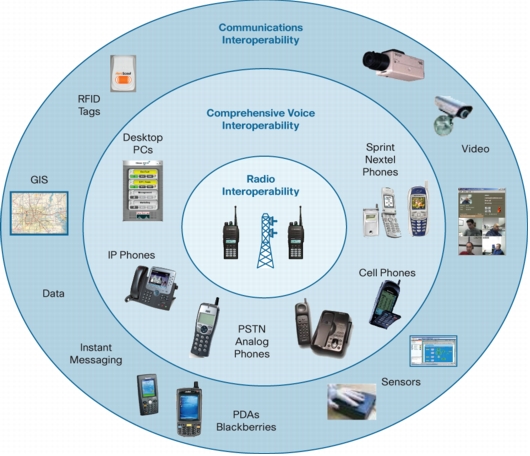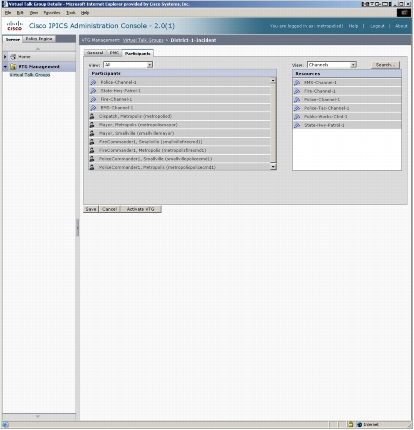Abstract
Challenges of Communications Interoperability-and the Price of its Absence
Immediate Challenge: Radio Interoperability
1. The radio spectrum is fragmented. The FCC originally allocated portions of the low end of the frequency range to public safety. As technology improved, the FCC began assigning frequencies in other bands to alleviate congestion. Today, public safety operates in 10 different bands.
2. Commercial, standards-based technologies have not been available. Historically, radio systems have been dominated by a few vendors with proprietary technology, and public safety represented a small market. Therefore, public safety could not take advantage of standardized or commercial off-the-shelf technologies, nor did it benefit from innovations in the broader market for communications technology and devices.
3. Radio equipment has a very long lifecycle, and funding is infrequent. By the time an agency purchases new radio systems, the new radios often are not compatible with those purchased earlier by neighboring jurisdictions.
Larger Challenge: Interoperability Is About More than Just Radio
• Video sent from surveillance cameras
• Data sent to and from the mobile data terminals in law enforcement vehicles, which operate over push-to-talk (PTT) networks
• Instant messages sent from computers and handheld personal digital assistants (PDAs) carried by field personnel
• Geographic information systems
• Hazardous materials databases
• Data from earthquake, air quality, and other environmental sensors
Figure 1. Expanding the Definition of Interoperability in Public Safety

Why the Need Has Become Urgent
Increased Interjurisdictional Cooperation
Proliferation of New Communications Technologies
• Traditional UHF, VHF, 700-MHz, and 800-MHz radios
• PTT radios
• Outdoor wireless radios using new public radio frequency allocations at 2.4 GHz and 4.9 GHz
• New trunking systems, which conserve spectrum and establish a queue to handle demand for voice or data channels
• PTT-over-cellular phones
• PDAs with instant messaging (IM) capability, especially useful for relaying numerical information such as location coordinates
Limitations of Existing Interoperability Approaches
• Swapping gear-In mutual-aid situations, some agencies equip first responders with multiple voice devices, such as two or three radios and a cell phone. This solution is an effective low-cost one for small events, such as crowd control, but it is ineffective for larger events and disasters. Furthermore, if the radio infrastructure sustains damage, communications cease-and command structures crumble.
• Mutual-aid channels-National or regional mutual-aid channels are set aside for use by multiple agencies that are collaborating for incident response. Although useful, mutual-aid channels can be difficult to use because of restrictions and guidelines governing usage. In addition, after first responders set their handsets to the mutual-aid channel, they cannot participate in their own agency's operational channel during the incident.
• Relaying communication through dispatchers-If decision makers in different agencies need to communicate through their respective dispatchers, escalating response can take longer. In addition, the inability to directly hear background noise or the urgency in the first responder's voice can compromise situational awareness.
• Radio interoperability gateways-These tactical solutions enable personnel using two or more different radio systems to join the same channel. But they do not provide a long-term solution to communications interoperability because they do not support standard phones, they do not enable commanders to monitor situations from outside the radio range, they are costly, and by tying up multiple frequencies they increase the likelihood that someone cannot join a channel, impeding effective response.
IP: A New Approach to Public Safety Interoperability and Collaboration
• IP supports new communications devices and technologies in addition to radios-Radios do not talk to radios; rather, people communicate with people. With IP standards-based technologies, people can communicate with other people regardless of the type of device or communications technology they are using. IP enables PTT everywhere, using radios, cell phones, IP phones, or analog phones. The location of the user becomes far less important, facilitating centralized or distributed command and control. That is, decision makers can monitor talk groups from home or even another country because of the global reach of IP. Furthermore, users can switch from one device to another-from cell phone to radio, for example-as events dictate or as people travel.
• IP enables flexible command and control and multiagency collaboration-With existing approaches to radio interoperability, anyone who has been issued a radio-or has seized one-can access channels. It is not possible to dynamically control access as the incident escalates and deescalates. With IP, in contrast, a dispatcher or incident commander can dynamically control all assets from a Web browser, enabling agencies to better support collaborative emergency services and communications. A communications interoperability system based on IP standards enables agencies to preserve their existing command and control and standard operating procedures. They gain more flexibility regarding how, when, and where they will engage in incident response, and how they will communicate with other organizations-irrespective of their location or radio technology.
• IP enables resilience-Radio infrastructures are subject to physical failures from fire, earthquake, power outage, and more. So is the public switched telephone network (PSTN). For example, months after Katrina, multiple primary public safety answering points (PSAPs), which relied on PSTN connectivity, were still not operational. "From Katrina, we learned that we cannot rely on any specific infrastructure: PSTN, radio tower, or other," says Kevin Ross of the New York State Emergency Management Office. "We need the option of reconstituting communications from a disaster recovery site that is on a different power grid, with different phone providers."
• IP scales for any size emergency-Tactical radio-to-radio interoperability bridges can falter under the high traffic volume of large-scale emergencies. They can also tie up multiple frequencies, potentially preventing first responders and commanders from joining a channel. With an IP-based system for communications interoperability, agencies can use a central, Web-based interface to scale and dynamically extend their span of control.
Cisco IP Interoperability and Collaboration System
• Unifies the chain of command-By delivering voice when needed, anywhere in the world with a network connection, Cisco IPICS makes it easier to extend, delegate, and escalate across the chain of command. If a riot breaks out, for example, a police chief who is away from the city and outside the coverage area can log in using a cell phone and participate in the event in real time. The Cisco IPICS solution can actually increase the effectiveness of mutual-aid channels by bringing them back from the scene to the IP network and distributing those channels to command and control at the dispatch center. Unlike public safety solutions designed for one layer in the chain of command, Cisco IPICS delivers actionable information to every layer: headquarters, field headquarters, PSAP and emergency operations center, mobile incident command, and field personnel and vehicles. By unifying the entire chain of command, Cisco IPICS enables public safety networking.
• Provides global reach-With Cisco IPICS, the physical location of commanders, field resources, and dispatchers becomes less of a concern. For example, an expert on a particular disease can provide real-time guidance to field personnel anywhere in the world from any Internet-connected PC, IP phone, telephone, or mobile cell phone. Public safety agencies with Cisco IPICS can also collaborate with enterprises, which become valuable resources for public safety when they give government agencies permission to use their IP-based resources such as streaming video of a hostage situation or fire, intelligent building management systems, and hazardous materials databases.
• Speeds decision making-By enabling people to communicate directly instead of through a dispatcher, Cisco IPICS enables people to more quickly obtain the information they need to make decisions. Members of the chain of command can participate from any location, using any radio system, IP phone, telephone, cell phone, or PC with the appropriate software.
• Improves flexibility of command and control-Cisco IPICS enables more flexible command and control for day-to-day operations as well as emergency response. Agencies can apply established memoranda of understanding defining policy and governance, such as controlling how many people can join a channel during normal operations and emergencies. Incident commanders can give permission for participants to talk or require participants to engage in listen-only mode. At emergency scenes, commanders can connect disparate radio and phone systems at any location with IP connectivity. The dispatch center does not have to be in the same location as the equipment. The Cisco IPICS system can reside in any hardened facility: a network operations center, PSAP, emergency operations center, or mobile command vehicle.
• Increases personnel effectiveness by reducing information overload-First responders can be overwhelmed by nonpertinent information transmitted over radio channels. Cisco IPICS enables incident commanders to selectively deliver information only to the people who need it, relieving specialized personnel from having to determine which communications are pertinent to their immediate responsibility. The incident command can push information to any individual on the system and can quickly integrate individuals into an incident talk group.
• Offers ease of use-Unlike radio interoperability gateways, Cisco IPICS provides an intuitive, Web-based interface that is easy for network administrators to use and maintain (Figure 2). Cisco IPICS features an incident management console that supports distribution of command and control as well as converged incident management communications systems, modalities, devices, and services.
Figure 2. Intuitive Interface Reduces Training Requirements

• Reduces costs-Cisco IPICS takes advantage of the same IP network that the agency already uses for data. By converging its previously separate radio, voice, video, and data networks, the New York State Emergency Management Office reduced recurring costs enough to fully fund a disaster recovery site. The return on investment results from lower labor costs associated with managing and maintaining communications technologies, dispatch, and interoperability systems and from enabling faster, better, and more effective emergency response.
• Before: The dispatcher in one jurisdiction calls the dispatcher in the other and relays the information, creating delays that can affect the outcome.
• After: The dispatcher in the second jurisdiction listens in, speeding the decision-making loop. Or, if the jurisdictions have a memorandum of understanding, the officer can communicate directly with the local dispatcher with a radio or cell phone. When multiple agencies converge in one area, they can use multiple communications technologies to reach their own networks and operational teams and stay in touch by a variety of channels.
• Before: The number of volunteer groups searching the area is limited by the number of available radios.
• After: More search groups can be dispatched because they can use cell phones to patch into channels.
• Before: The chief uses a cell phone to call a dispatcher, who relays information between the chief and personnel at the scene.
• After: The chief uses a cell phone to patch into the radio environment, increasing situational awareness and decreasing delays.
• Before: Communications would have been severely limited for the three or four days the phone company needed to bring in phone lines and T1 lines for Internet connectivity.
• After: Using Cisco IPICS, the agency established communications available over an 800-MHz trunking system in just 2.5 hours, using a satellite dish for network connectivity.
Conclusion
For More Information